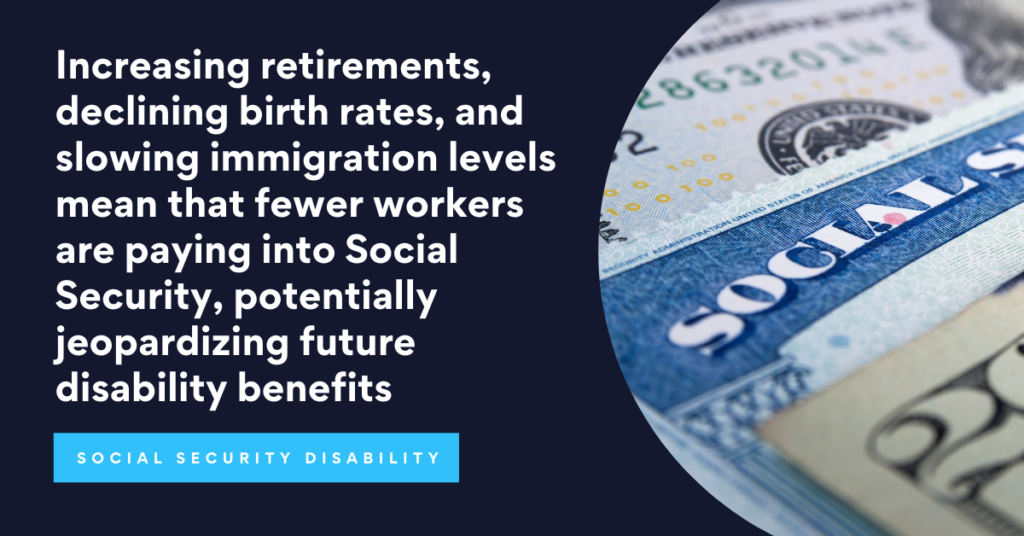Will Social Security Disability Be Around Forever?
How Reliable is Social Security Disability?
We tend to take it for granted that Social Security disability – the government program that pays benefits to disabled people – will always be there to provide individuals with disabilities a “social safety net” to keep people from falling into poverty or worse. However, recent events – most notably the financial collapse of the late 2000’s and the ongoing Covid pandemic – have caused many people to question the ongoing stability of Social Security (including Social Security disability). Many U.S. residents wonder, “Will Social Security disability exist forever?”
 The answer, as you’d expect for a program as large and complex as Social Security, is a bit complicated. Social Security disability benefits may be available to qualifying U.S. residents “forever” (at least for the foreseeable future), but it depends on how the government decides to manage the entire Social Security program.
The answer, as you’d expect for a program as large and complex as Social Security, is a bit complicated. Social Security disability benefits may be available to qualifying U.S. residents “forever” (at least for the foreseeable future), but it depends on how the government decides to manage the entire Social Security program.
In other words, whether Social Security disability is around “forever” for people with disabilities is directly tied to funding for the entire Social Security system — a system that provides support for retirees, people with disabilities, and survivors.
And long-term, sustainable funding for the entire Social Security system is by no means guaranteed… as we’ll explore in this article.
That’s not to say there isn’t hope, though. Let’s dig into what’s going on.
Social Security Disability: Part of a HUGE System
The Social Security Administration (SSA) says that “there is no ‘expiration date’ set on your Social Security Disability payments” (other than when you reach retirement age and qualify for Social Security Retirement benefits, or SSR).
But this ignores one gigantic fact: the survival of Social Security disability depends on the survival of the entire Social Security Administration.
The Social Security Administration
Created in 1935 and originally called the “Social Security Board,” the SSA is a HUGE part of the federal government. It employs around 60,000 people and oversees over $1 trillion of annual expenditures for retirement, disability and survivor benefits. Funding for Social Security comes from payroll deductions collected during wage earners’ working lives.
The theory behind these programs is that by collecting a portion of a worker’s wages (currently 6.2% each by the employer and the employee, for a total of 12.4%) during their productive years, the government can provide a fund from which to pay them or their survivors when they become disabled, retire at a certain minimum age, or die.
The Famous “Trust Funds”
To that end, Social Security set up a pair of trust funds — the Old-Age and Survivors Insurance Trust Fund and the Disability Insurance Trust Fund — to hold, invest, manage, and pay out that money (we will refer to these funds collectively as the Trust Funds in this article).
For Social Security disability program specifically, funds are collected in and paid by the Disability Insurance Trust Fund.
The money going into the Trust Funds comes from three sources:
- 89% comes from the 12.4% payroll tax on employers and employees discussed above.
- 3.4% comes from the income taxes Social Security recipients pay on their benefits, which are only taxed to a relatively small degree and only for a relatively low number of relatively higher-income recipients.
- 7.6% comes from interest earned on the money already in the Trust Funds.
How Much Money is in the Social Security Trust Funds?
As reported by AARP, the Trust Funds held $2.9 trillion at the end of 2019, but as time goes on, the Funds are paying out more than they take in (see below). This is in large part because the “Baby Boomer” generation — that huge number of people born between the end of World War II and the early 1960s — is gradually working its way through the system and receiving benefits from the Trust Funds.
 At the same time, birth rates and immigration are not keeping up with that aging population, so there are fewer workers paying into Social Security.
At the same time, birth rates and immigration are not keeping up with that aging population, so there are fewer workers paying into Social Security.
In fact, according to a report, “In 1950, there were 16.5 workers for every retiree receiving benefits. By 2018, that ratio had fallen to 2.8, and [in] 2020, [it was] about 2.75, and [it] is expected to fall to 2.3 in 2035. There simply are not enough workers compared to Social Security beneficiaries to sustain benefits at the level that current formulas provide. More Americans are living longer and continuing to receive benefits, while a declining birth rate has resulted in a smaller workforce.”
If Nothing Changes, When Will Social Security Run Out of Money?
At current and projected rates of income and spending, the Social Security system has a problem — one that impacts ALL Social Security programs, including Social Security Disability Insurance (SSDI).
The lack of sufficient incoming funds has set the Trust Funds up to become depleted – not completely exhausted, but depleted – around the year 2035. At that time, unless changes are made (and we will discuss possible changes below), the Social Security system will not be able to pay the full amount of benefits due because it will only be able to pay out what it takes in. There will only be enough incoming money to cover about 79% of the promised benefits.
This means that in a little more than a decade, people who rely on Social Security disability to cover their costs of living will be facing serious benefit cuts (and it’s not as if Social Security disability benefits are especially generous to begin with).
Retirees relying on Social Security Retirement (SSR) benefits will also face serious cuts, as well.
Can We Fix It?
All is not (yet) lost. Policymakers have many options when it comes to reforming the Social Security system — and preserving funding for Social Security disability, among other programs.
What changes could be made to keep the Trust Funds solvent and the Social Security disability system (and other Social Security programs) paying full benefits beyond 2035?
Options include:
- Right now, wage earners pay Social Security taxes only on the first $137,700 of their income no matter how much they earn. Raising or eliminating that cap would result in significantly more money coming into the Trust Funds.
- The percentage rate of the Social Security income tax (currently 12.4% total) could be increased, for some or all wage earners.
- On the back end (benefit payouts), the full retirement age (currently 66, and gradually on its way to 67) could be further raised so that less money is paid out in each given year.
- Also on the back end, the “benefit formula” (the way benefits are calculated based on the amount paid in during the wage earner’s life) could be changed so that the total average benefit payout per person is lower.
- The annual cost-of-living adjustment increases could be slowed by changing the way inflation and costs-of-living are calculated for this purpose.
- Beneficiaries could be “means tested” and benefits reduced for high-net-worth individuals.
None of these options is perfect. And all of them are politically controversial.
But the good news is that they exist. There are options.
“Ok, But What Will the Government Actually Do?”
Some combination of these measures will almost certainly be put into place so that the system can be preserved into the future. This is even more likely considering the COVID-19 pandemic, which has damaged the economy in ways that will affect these calculations. One recent report from the Center on Budget and Policy Priorities, a nonpartisan research institute, put it this way: “The COVID-19 pandemic, its economic repercussions, and the legislative response will affect Social Security’s near-term outlook in several ways. Although their magnitude is very uncertain, they will clearly worsen the outlook for the trust funds.”
So… Is Social Security Disability Going to Be Around Forever?
So, back to the original question: “Will Social Security disability be around forever?”
As with other Social Security programs, the most plausible answer is “yes, but…” with a lot of qualifiers. Social Security disability might offer lower benefit levels than have been historically typical, but it will almost certainly exist far into the future. It seems implausible that the U.S. government would allow a significant percentage of its population to fall into poverty, hunger and homelessness. The political ramifications of allowing Social Security to collapse, too, are seemingly impossible to fathom.
The “social safety net” for people with disabilities will probably stick around, but it might look different than it does now.
For a FREE, no-obligation consultation with an experienced North Carolina disability lawyer, please call 1-800-525-7111 or complete the fast and easy form below. There are no upfront costs, and you won’t pay any attorney fees unless we get you the disability benefits you need and deserve.